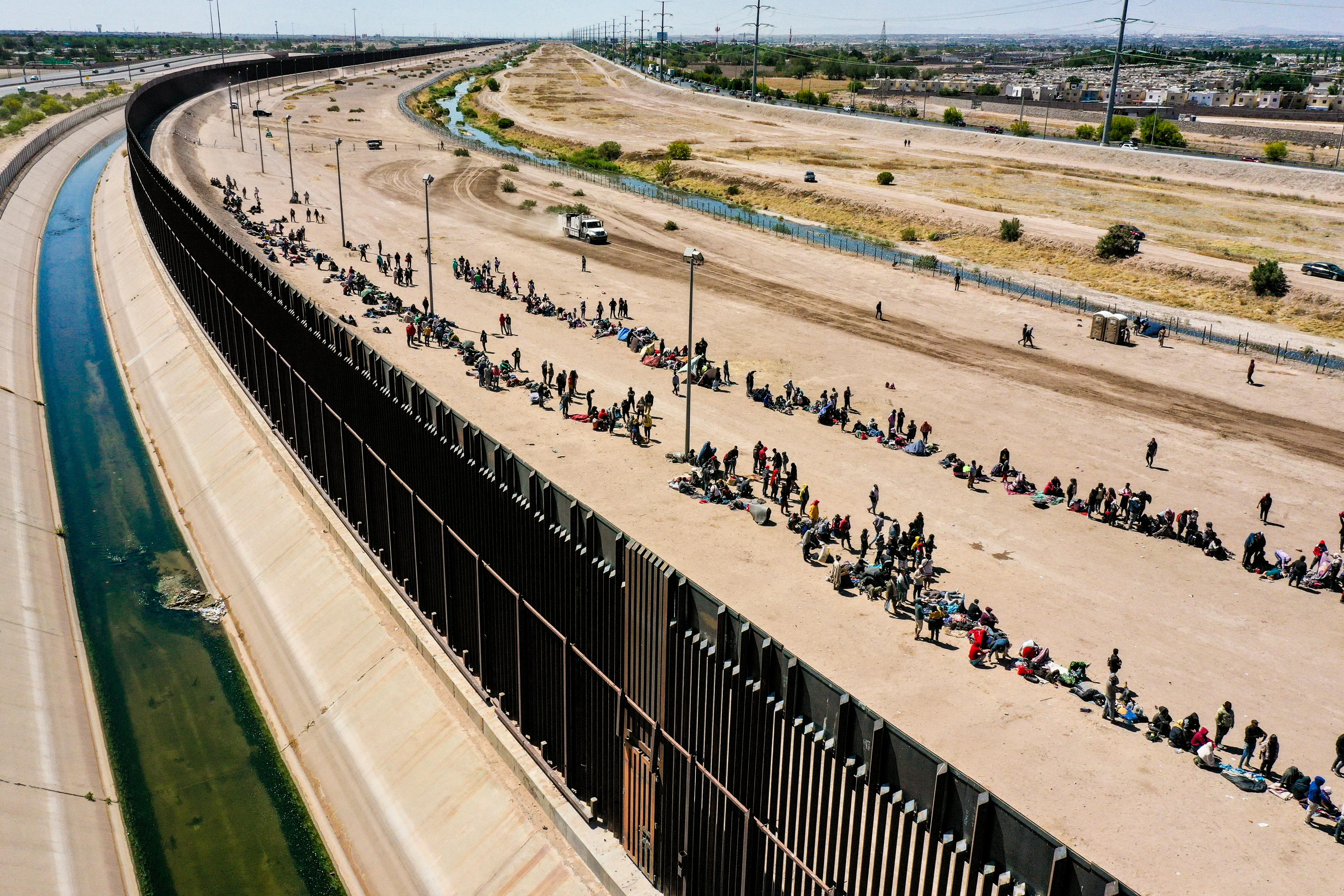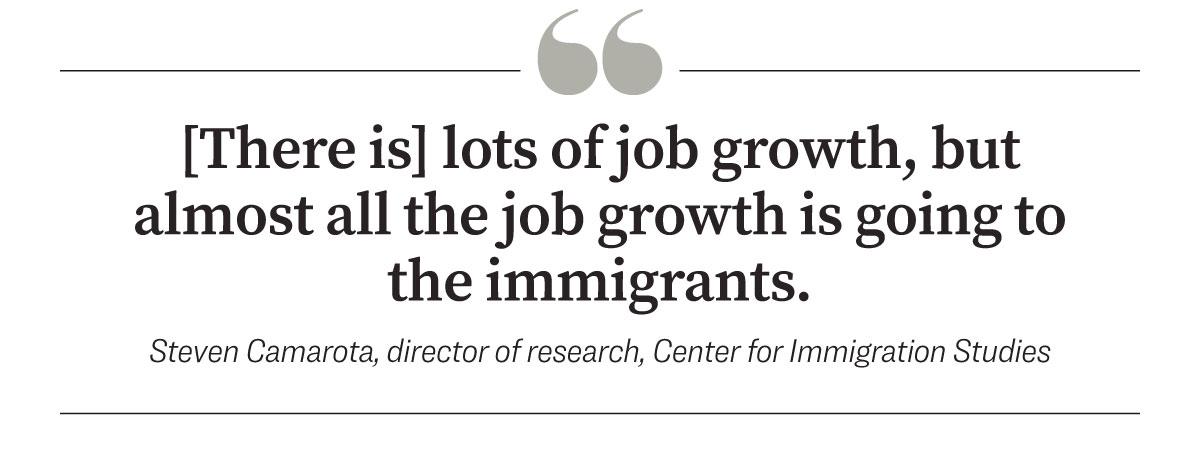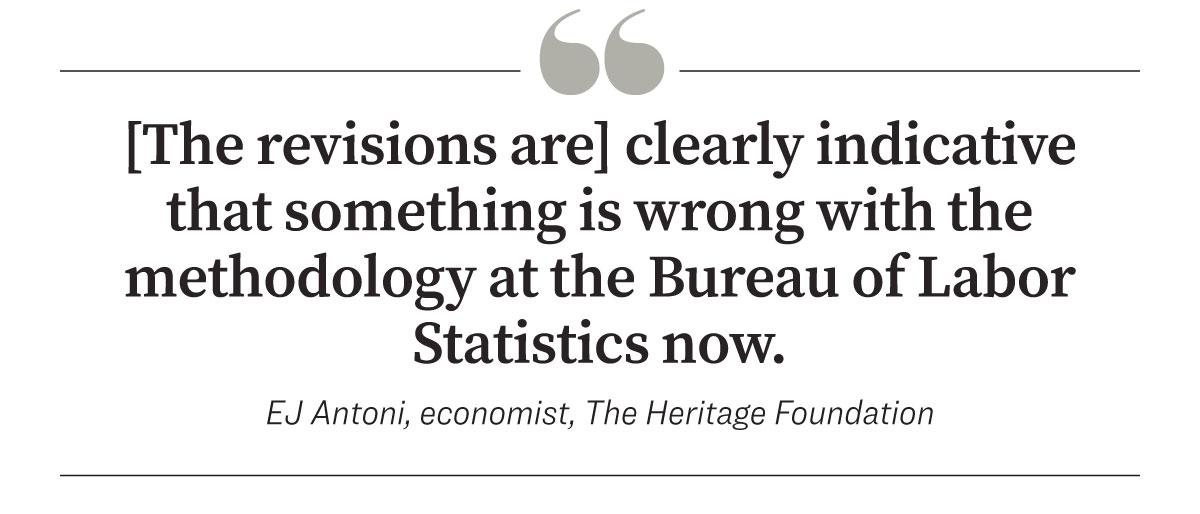‘That’s a big problem. What we’re interested in is how the economy is working for American citizens,’ says an economist.

Economists are expressing concern over the increasing number of illegal immigrants in the United States, who they believe are obscuring the actual condition of the jobs market and the U.S. economy.
For the last few years, the headline employment figure has been impressive. The country has recovered the lost jobs from the government-imposed shutdowns during the pandemic and added a few million more, despite a climate of high inflation and rising interest rates.
In 2023, the economy added approximately 3 million new positions. To kick off 2024, more than 800,000 new jobs have been added.
The labor market data is critical as it helps determine the Federal Reserve’s interest rate policy.
Federal Reserve chairman Jerome Powell said on March 20 that the central bank is monitoring the labor market “very carefully” and isn’t observing any “cracks.”
“We follow all the possible stories that are out there about there being cracks, but the overall picture, really, is a strong labor market,” he noted. “Things are returning more to their state in 2019.”
However, a closer look at the household survey of the employment report reveals a more gloomy picture. Employment for native-born Americans has been in decline over the past four years. This means that all of the job gains have gone to foreign-born workers, including both legal and illegal immigrants.
According to the Bureau of Labor Statistics (BLS), the number of immigrants—legal and illegal—working in the United States grew by 3.4 million between February 2020, shortly before the onset of COVID-19, and February 2024. The number of U.S.-born workers, however, declined by 78,000 during the same period.
In addition, during the Biden administration, there have been approximately twice as many illegal immigrants as legal immigrants entering the country, according to a study by the Brookings Institution.
“That’s a big problem,” says economist Stephen Moore.
“What we’re interested in is how the economy is working for American citizens. So, we’re distorting the jobs market with all of the illegal immigrants,” he told The Epoch Times.
Mr. Moore, who served as an economic adviser to former President Donald Trump, criticized the Biden administration for turning the U.S. immigration system “upside down.”
He argued that the U.S. economy “desperately needs” more legal immigrants, who possess high skill levels or special talents, rather than illegal immigrants, who tend to be less educated.
According to the Bureau of Labor Statistics (BLS), the number of immigrants—legal and illegal—working in the United States grew by 3.4 million between February 2020, shortly before the onset of COVID-19, and February 2024. The number of US-born workers, however, declined by 78,000 during the same period.


(Top) Construction workers help build a residential building in Miami on Jan. 5, 2024. (Bottom) Workers handle parts for Fiat Chrysler Automobiles as they come off the press at the FCA Sterling Stamping Plant in Sterling Heights, Mich., on Aug. 26, 2016. (Joe Raedle, Bill Pugliano/Getty Images)
‘Very Troubling’
The BLS includes illegal immigrants in the labor statistics, identifying them as “undocumented workers.” However, the agency doesn’t disclose the data publicly and instead groups legal and illegal immigrant job data together.
Many economists have been surprised by the growing employment gap between native- and foreign-born workers since October 2019.
The contrast in the past year is even more striking. According to the BLS, native-born employment fell by 651,000 in March 2024 from the same period last year, while foreign-born employment climbed by nearly 1.3 million.
According to Steven Camarota, director of research for the Center for Immigration Studies (CIS), it is hard to know the exact number of illegal immigrants who have recently entered the country and found employment.
However, he estimates roughly half of the job gains among foreign-born workers have gone to illegal immigrants over the last year.
Mr. Camarota notes that the government should know all economic activity and job creation in America, so counting illegal immigrants is not a problem.
“What I do think is problematic is that you can see a low unemployment rate and more importantly, lots of job growth, but almost all the job growth is going to the immigrants. That’s the distortion,” he told The Epoch Times.
There were a total of 31 million immigrant workers as of March 2024, constituting nearly 20 percent of the U.S. labor force. Mr. Camarota estimates that at the beginning of this year, roughly 9 million of these workers were illegally present.
The Congressional Budget Office estimated that the number of “immigrants with a nonlegal or pending status” increased by 2.4 million in 2023.
This group includes individuals who have been apprehended and released into the country, individuals who have managed to evade the Border Patrol, officially known as “gotaways,” and individuals who have overstayed their visas. The figure is modified to account for deaths, legalizations, and departures.
According to Mr. Camarota, the rise in illegal employment conceals the true state of the U.S. jobs market. There has been a concerning decline in the labor force participation of U.S.-born working-age men from the 1960s to the present. And this decline is more pronounced among the less educated.
Globalization, outsourcing of jobs overseas, generous welfare and disability policies, and wage stagnation are among the factors that have contributed to this drop over the years, Mr. Camarota said.
“That decline in labor force participation, particularly among U.S.-born men, is linked to many social problems, from overdose deaths to crime,” he said.
Hence, he argued that the government is missing the overall picture by focusing on headline data and reporting strong job growth, and not saying it’s fueled primarily by low-wage illegal immigrants.
“That’s very troubling,” he said.
Another issue with more illegal immigration is that it drives down wages for American workers.
According to EJ Antoni, an economist and research fellow at the Heritage Foundation, one of the key reasons President Joe Biden is polling so poorly among voters is “because they are not the ones getting the jobs.”
As a result of the flood of cheap labor, American workers also earn less than they would otherwise, he told The Epoch Times.
The Economic Policy Institute, a Washington-based think tank, rejects the notion that illegal immigrants are hurting U.S.-born workers.
Experts Heidi Shierholz and Daniel Costa at the Institute wrote in a recent report that “the idea that immigrants are making things worse for U.S.-born workers is wrong.”
“The reality is that the labor market is absorbing immigrants at a rapid pace, while simultaneously maintaining record-low unemployment for U.S.-born workers,” they stated.


Surprise Effect on Economic Growth
Many economists have been perplexed by the strong employment growth in recent years. They believe that the labor market was far too tight and needed to ease dramatically to control inflation. Many have overlooked the impact of illegal immigration.
The study by the Brookings Institution states that strong job growth is aligned with large immigration flows and this is why current employment growth is not putting upward pressure on wages and price inflation. In other words, since the majority of positions are filled by illegal immigrants earning low wages, the effect on inflation is small.
“The unexpectedly high level of immigration also explains some of the surprising strength in consumer spending and overall economic growth since 2022,” the study stated.
According to its rough estimates, the rise in immigration boosted real consumer spending growth by 0.1 percentage point in 2022, 0.2 in 2023, and an expected 0.2 in 2024. In addition, the increase in immigration boosted real gross domestic product (GDP) growth by 0.1 percentage points annually, the study showed.
Illegal immigrants boost GDP because more people are in the labor force, which is one of the key inputs of the economy.
The increase in the number of immigrants in the labor force since Joe Biden took office has added over $300 billion to the GDP, according to Mr. Camarota’s estimates. The economy grew by roughly 1 percent over a couple of years because of immigrants. And Mr. Camarota estimates that about half of that is generated by illegal immigrants.
However, a larger economy does not necessarily imply a better economy and more wealth for the existing population, Mr. Camarota argued. Immigration reduces per-person GDP by causing the population to grow faster than the economy, he added.
Many economists believe that illegal immigrants differ from legal immigrants in that they tend to exert downward pressure on wages and economic productivity in the short term.

Labor Data Revisions
Another development that has captured attention is a series of unusual downward revisions to the federal government’s monthly jobs report.
Every month, the financial markets brace for the BLS’ jobs report, a snapshot of information to determine how the U.S. labor market is performing.
However, economists and market analysts have noticed a trend for the past year: sizable downward revisions to the monthly BLS data have been quietly made after the initial release of data.
For example, the BLS reported on Feb. 13 that the U.S. economy added 353,000 jobs in January, much better than expected. On April 5, however, the agency said that the January data had been revised downward by 97,000 to 256,000.
This was ubiquitous throughout last year, too. The BLS’ downward revisions, which have occurred in 12 of the previous 14 months, have totaled nearly 585,000 jobs.
Many market experts viewed the changes as showing that the U.S. labor market is normalizing. A chorus of critics on social media were quick to question the BLS’ motives. Some also leapt to the conclusion that the high number of corrections was due to illegal immigration.
And others doubted the accuracy of the federal agency’s data collection methodology, considering how often the jobs reports have been overstated.
“I don’t want to criticize the data collection,” Lauren Saidel-Baker, an economist with ITR Economics, told The Epoch Times. “They have a very tough job, they’re absolutely doing the best they can. But there will always be some revisions as we get better data and additional data.”
The agency reports that its “field economists” collect data from survey respondents through a variety of methods, including personal visits, mail, telephone, email, and video calls.
Mr. Moore says that there will be mistakes in the data collection “but you expect those errors to be random.”
“But they haven’t been random. They’ve all been in the same direction,” Mr. Moore said. “I don’t think there’s anything sinister. I don’t think they’re trying to manipulate the data. There’s something wrong with the way they’re measuring job growth. We have a lot of multiple job holders now and they count those.”


According to the latest figures, approximately 8.4 million people are working two or more jobs.
Economists also note the rising disparity between the two surveys. Each month, the BLS conducts two surveys: the “establishment survey,” which provides payroll statistics, and the “household survey,” which calculates the unemployment rate. The former includes every job a person holds, while the latter avoids duplication in the statistics.
There have been several months since the beginning of 2022, when the disparity between the two surveys was significant. In fact, since January 2022, the establishment survey reports 8.1 million jobs generated, compared to 4.4 million in the household survey. Hence, some analysts argue that the household survey tends to give a more accurate picture of the job market’s health.
In February, for example, the establishment portion of the jobs report highlighted 275,000 new jobs. However, the household part revealed the economy lost 184,000 jobs.
If the revisions are happening regularly for a prolonged period, it might be time to make some changes in the data collection process, according to Mr. Antoni.
“It’s clearly indicative that something is wrong with the methodology at the Bureau of Labor Statistics now; exactly what that is remains to be seen,” he said.
He likened the current situation to 2008, when basic economic conditions were deteriorating so fast “that it was difficult for the BLS to keep up with those changing conditions.”
During the 2008 Global Financial Crisis, the BLS issued downward revisions to 11 of the 12 months, totaling more than half a million.
“We could be facing something similar to that today,” Mr. Antoni said. “There are a lot of hangover effects from the pandemic, more specifically from the government response to the pandemic. And we are still dealing with that today and we are still trying to make sense out of it.”
Ultimately, Mr. Antoni says, the U.S. government needs to change its methodologies because the numbers these agencies report are not comparable to real-world data.
Likewise, should the current influx of illegal immigration persist, economists may demand greater transparency from the government regarding the number of illegal immigrants entering the workforce.



